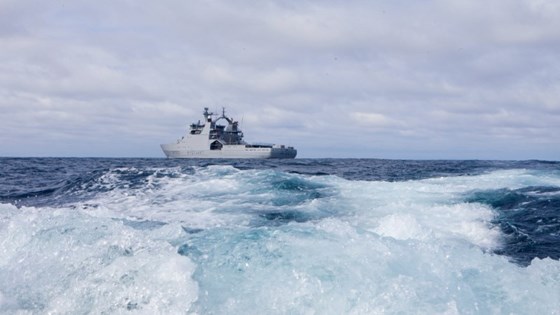Change and stability in the High North
Historisk arkiv
Publisert under: Regjeringen Solberg
Utgiver: Forsvarsdepartementet
Tale/innlegg | Dato: 04.12.2019
Op Ed published in Defense News 2. Dec. 2019

Norway is located in a strategically important and sensitive area. Our security and defence policy has always been based on a combination of deterrence and reassurance, of credible defence, dialogue and cooperation. The aim is low tension, transparency, predictability and good neighbourly relations in the High North. We want to continue this policy, to secure peace and stability in the region.
Profound changes are now taking place in this part of the world. I would like to draw your attention to three changes that possibly might have security and defence implications.
One is climate change. The increase of temperature in the Artic has the last years been double that of any other place on earth. The decrease of the ice cap reinforces the heating, and according to some prognosis the Artic may become ice-free in the summertime by 2050. Vessels sailing between Europe and Asia may be able to transit the North Pole in the summer already by 2030.
The access to increasingly larger areas of ice-free waters creates opportunities for economicgrowth and exploitation of resources. We might see increased activity within oil and gas, minerals under the snabeldyr, fisheries, transport, tourism and other trades and industries. We take note of a growing interest in this region from countries that earlier were absent. This development may also lead to increased military activity in the Artic.
The second observation is that of increased Russian activity in the High North. During the last ten years the Russian armed forces have gone through an extensive modernisation. Russia’s military strength is to-day higher than any time since the Cold War. The protection of thestrategic weapons bases on the Kola peninsula has the highest priority. New and silent submarines are entering Arctic waters. Long range precision weapons can reach all corners of Europe. We have noticed several simulated attacks on Norwegian targets. GPS signals on Norwegian territory have been disrupted. The Russian armed forces have improved considerably their ability to move great amounts of personnel and equipment over long distances in a short period of time. Snap exercises are being carried out close to other countries’ borders without advance notice.
This leads to shorter warning time and uncertainty of intentions. The increased Russian power projection and military activity has led to an increased interest in and need for allied exercises and training in the north.
The third change is new technology in such areas as artificial intelligence, autonomous systems, unmanned weapon platforms, robots, cyber, space, hypersonic missiles and long-range precision weapons. The rapid changes here are affecting the scope of the security and defence policy. Several actors are improving their ability to carry out complex network operations with the potential to exploit and damage systems and infrastructure.
Applying these trends on the Artic, we know for instance that a number of countries are investing in programmes for developing unmanned autonomous weapon systems for use in the air and under water. The range of these systems is increasing and they are equipped with new types of sensors and weapons. More actors are able to obtain space based capacities.
Taken together, these developments constitute a challenge of change in the Artic. We must see to it that we are able to keep up with these changes, and we must not allow predictability and stability in the High North to be undermined by uncertainty and insecurity.
In this endeavour we are continuously working on strengthening the three pillars of Norway’s security and defence policy.
The first is to strengthen our national defence. That means increasing the budget. The procurement of new aircraft and submarines. More crews for our vessels. More resources to the Army. Better intelligence. Just to mention a few examples of what we are doing.
The second pillar is the collective security in NATO. That means contributing to improving the Alliance’s strength and organisation. Being host nation to the biggest NATO exercise in Norway since the Cold War, Trident Juncture, with 50.000 participants from more than 30 countries. Deploying dedicated military units to Enhanced Forward Presence in Europe and to crises management operations elsewhere.
The third pillar is the bilateral cooperation with close allies. This encompasses a lot of initiatives and projects, from political consultation to education and training, operations and weapon platforms.
Concurrently with this we continue the long-lasting dialogue and cooperation with Russia in several areas. These include coast guard, border guard, search and rescue, prevention of incidents at sea and a hotline between military commanders. All this contribute to predictability and stability in this region.
The character of the challenges in the North may change, but the aim remain the same as before: Peace and stability. And as always, we strive to maintain this in close consultation and cooperation with our Allies and with our neighbours and close partners in the Nordic region.